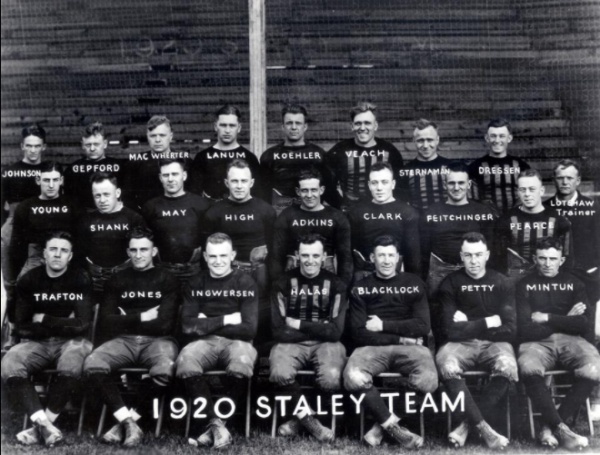The NFL's Humble Beginnings
9/27/2017
The National Football League kicked off its 98th season earlier this month and now Canton, Ohio is on the clock. Two years from now, the NFL will kick off its 100th season that will culminate with the league’s centennial celebration on Sept. 17, 2020, three years to the day from last Sunday.
Canton, and Johnson Controls Hall of Fame Village, will take center stage for the rest of the world as the Pro Football Hall of Fame celebrates all that is great about the game of football.
Around the world, people know the NFL as a $14 billion-a-year business. It’s surprising to many that the league has such humble beginnings. A variety of problems plagued the game of pro football with increasing regularity in the early 1900s. The need for a sense of order brought men such as George Halas, Ralph Hay, Jim Thorpe, Carl Storck, Stan Coffal and Art Ranney together in Canton to form the first professional football league. While many fans can tell you in detail historical and statistical information related to their favorite teams and players, there are a few things you probably did not know about the founding of the NFL.

The NFL was originally founded as the American Professional Football Association (APFA) on Sept. 17, 1920 in Canton. The first order of business at the organizational meeting held in Hay’s Hupmobile showroom, was that the Massillon team sent word, through Hay (the owner of the Canton Bulldogs), they would not be joining the association. The teams’ representatives then unanimously elected Thorpe, the Bulldogs star, as their first president. Thorpe’s name recognition helped the national appeal of the upstart league.
When news of the APFA’s founding was made public it had little fanfare. The top headline in the newspaper the next day was the Bulldogs’ signing of future Pro Football Hall of Fame tackle Wilbur “Pete” Henry, while the birth of the new pro football league was relegated to Page 3. According to newspaper reports from the surrounding areas, the goals of the new venture would be to combat players’ high salary demands, to keep players from jumping from team to team and to protect college eligibility by preventing college players from “moonlighting” with pro teams.
The Racine (Chicago) Cardinals and the Decatur Staleys are the only two teams who attended the APFA’s organizational meeting and continue to operate in the NFL today. The Cardinals are now known as the Arizona Cardinals, while the Staleys moved from Decatur to Chicago and are known today as the Chicago Bears. While the meeting minutes, which are on display at the Hall of Fame, stated a fee of $100.00 be charged for membership in the association in 1920, the Bears and Cardinals franchises were valued by Forbes this week at $2.85 billion and $2.15 billion, respectively.
Apparently, Akron Pros’ manager and first secretary and treasurer of the APFA, Ranney wasn’t even sure where the Cardinals played. The meeting minutes mistakenly listed the Racine Cardinals, who played home games at Normal Park on Chicago’s Racine Avenue, as being from the Wisconsin city of the same name. The Cardinals franchise is the oldest continuously operating organization in pro football history. They trace their lineage back to 1898 when Chris O’Brien formed the Morgan Athletic Club.
The APFA modified its name to the NFL in 1922 and there are eleven players, coaches and contributors enshrined in the Pro Football Hall of Fame whose careers date back to before the name change. Those Hall of Famers are: Joe Carr, Guy Chamberlin, Jimmy Conzelman, John “Paddy” Driscoll, Joe Guyon, George Halas, Wilbur “Pete” Henry, Earl “Curly” Lambeau, Fritz Pollard, Jim Thorpe and George Trafton. These men are the pillars that the NFL was built upon in its earliest years. However, throughout the league’s 98-year history, over 29,000 people have played, coached or administered the game at the professional level. So, when we celebrate the NFL centennial on Sept. 17, 2020 in the birthplace of the NFL, we are honoring the legacies of each and every person who helped move this great game forward.
Go back to all blog listings